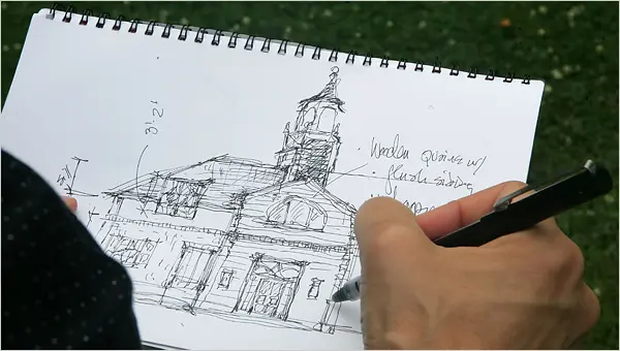New York Times "Even a Master Needs Help Sometimes"

Even a Master Needs Help Sometimes
August 5, 2007
THE two architects, married though they don’t advertise it, pulled into the short, slightly overgrown driveway of the big brick carriage house, designed in 1919 by John Russell Pope to shelter horses and their grooms in grand style.
Anne Fairfax and Richard F. Sammons, partners in the firm that redid Sarah Jessica Parker’s townhouse in Greenwich Village a few years ago, had arrived in grand style, too.
Driving a shiny Morgan sports car, with the top down and the gravel crunching under their wheels, they might have been the owners, just down to check out a promising filly.
Seemingly more stables than carriage house, the building was lived in off and on for half a century by Cyrus R. Vance, one of President Jimmy Carter’s secretaries of state. It is now owned by the United States Golf Association, which uses the estate’s main house — also designed by Pope — as a museum. The golf association bought the carriage house from the Vances in 2000, 28 years after it purchased the main house. The association is now selling off the carriage house with 14 surrounding acres — and a deed restriction that allows only one more house to be built on the land — for $2.8 million.
Fairfax & Sammons, as the architects’ firm is known, chose the property — which seems a bit dated, with too many small bedrooms and no coherent plan for modern living — to show how the next owner might make it into a showplace for more than just thoroughbreds.
The first thing they wanted to change was the driveway: too short.
“No M.L.D.,” Ms. Fairfax said knowingly, and Mr. Sammons nodded.
M.L.D.?
“Mile-Long Driveway,” he explained. “It’s de rigueur for any country house: to delay gratification, put in a bit of a chicane — a curve.”
So before they even went into the house, the partners stood in the back and decided to make it the front.
The existing driveway could become the service entrance, they said. They decided to bring guests in at the far corner of the property, curve the driveway around so they wouldn’t see the house at first, and then plant an allée of trees along the last straight run to what is currently the rear facade.
In fact, despite Pope’s clear genius — what is now the association’s museum is a gem — the rear elevation of the carriage house does seem to be missing something. To begin with, a huge chimney runs up the back, without even an opening for a barbecue on the terrace below it. And the arrangement of windows looks a bit haphazard, a trifle unfinished; perhaps Pope was already dreaming of the lovely pavilion he would create 17 years later: the Jefferson Memorial in Washington.
“As architects on a project like this, we take a back seat,” Mr. Sammons said. “We try to carry out what the first architect would have done if confronted with the same problems as we are now.”
And one of the problems was to make a more imposing, and more interesting, entrance.
Another concern, Mr. Sammons said, is that the house appears to be sitting right on the ground.
“They started to do that in the 1920s,” he said. “You see it in ‘The Philadelphia Story,’ when Hepburn just walks in and out.” Here, waist-high shrubbery doesn’t help, making the house seem to sit lower than it actually does.
Mr. Sammons said that Pope was clearly a master at designing in brick: “nice joints laid in a Flemish bond.” But the original carriage house might — or should — have had a slate roof, he said, not the asphalt shingles it has now. The shutters, too, are missing, with only their iron pintles left exposed. “First, the shutters go back on,” he said, “and then a slate roof.”
The two architects finally went inside, to find one great surprise: a wonderful high-ceilinged gathering/living room, 32 feet by 36 feet, with the huge fireplace that belonged to that awkward chimney. The thought of the buzz of race-time festivities sprang to mind: women in white linen and spectator pumps, men in blue blazers and striped ties, celebrating after a particularly fortuitous win.
The main house was built for Thomas H. Frothingham. a New York City stockbroker who commissioned Pope to design it and its dependencies in 1919. Mr. Frothingham named the 300-acre estate Dogwood and hired Ferrucio Vitale, a landscape architect, to design the grounds.
In those heady days of high finance and speculation, Mr. Frothingham soon landed in trouble. “In 1921, with the paint barely dry on the walls, a petition in bankruptcy was filed by creditors against Thomas Frothingham, who was a partner in the brokerage firm of Potter Brothers & Company,” according to “The Somerset Hills” (Mountain Colony Press, 2005), a weighty compendium of grand houses. John K. Turpin is one of its authors. and besides writing about New Jersey’s grandest houses, he owns the real estate company that is listing the carriage house.
Mr. Frothingham eventually lost the house, and in 1926, Dogwood was sold to John Sloane, the chairman of the W.&J. Sloane furniture chain. One of the Sloane daughters married Cyrus Vance, then a young lawyer and the family converted the carriage house into a residence for them.
A week after their visit, the architects had fine-tuned their proposal, and it wasn’t going to be cheap: close to $1 million for both architecture and landscaping. Still, with estates in this neighborhood routinely going for millions of dollars, it might strike a potential buyer as a sound investment.
Sitting at a conference table in their offices on Gansevoort Street, in the meatpacking district, Ms. Fairfax and Mr. Sammons unrolled sketch after sketch, some drawn by her, some by him.
But they all showed the same concept: the back had indeed become the front.
And the horse stalls — long ago converted to small guest bedrooms — had reverted to stables and garages: horses on one side and collectible automobiles (like those Mr. Sammons fancies) on the other. At one end was a mechanic’s shop; at the other was a tack room.
The imagined client will ride, of course, and may well be part of the Bedminster Hunt, Mr. Sammons said. Upstairs in the main part of the carriage house, several smaller rooms have become a 17-by-18-foot master bedroom, with a pair of owners’ closets and a luxe master bath, with the bathtub positioned squarely under a newly created half-round window filled with little panes of glass.
A teenager or in-law gets a private suite, with a separate set of stairs leading from one side of the living room.
But by far the most significant transformation, as the architects foretold, is in the approach — totally relandscaped with the drive starting at the far corner of the property.
The architects chose to leave the chimney exactly where it is. After all, it goes with the big fireplace in the living room, well-positioned in the middle of the south wall.
Then, in a feat of architectural legerdemain, they added an enclosed portico, with a centered entrance door. Inside is a high-ceilinged entrance hallway (above is the new master bath). The chimney is still in the middle of the old exterior wall, flanked by twin entrances to the living room.
“We did a little Mount Vernon number by using flush boards on the front portico instead of bricks,” Mr. Sammons said.
Leading up to this new entranceway is an appropriately landscaped semicircular stone staircase and terrace, set off by low stone retaining walls on each side.
“The back had been a ho-hum moment,” Ms. Fairfax said. “There was no real entrance to the house, so it became very clear what we had to do.”
Mr. Sammons nodded. “We flipped the site,” he said, “and it isn’t the first time we’ve done that.” The newly created stone steps have their historical allusion: to the Villa Poiana, Palladio’s 16th-century masterwork near Vicenza.
What did you expect from a pair of classicists?

